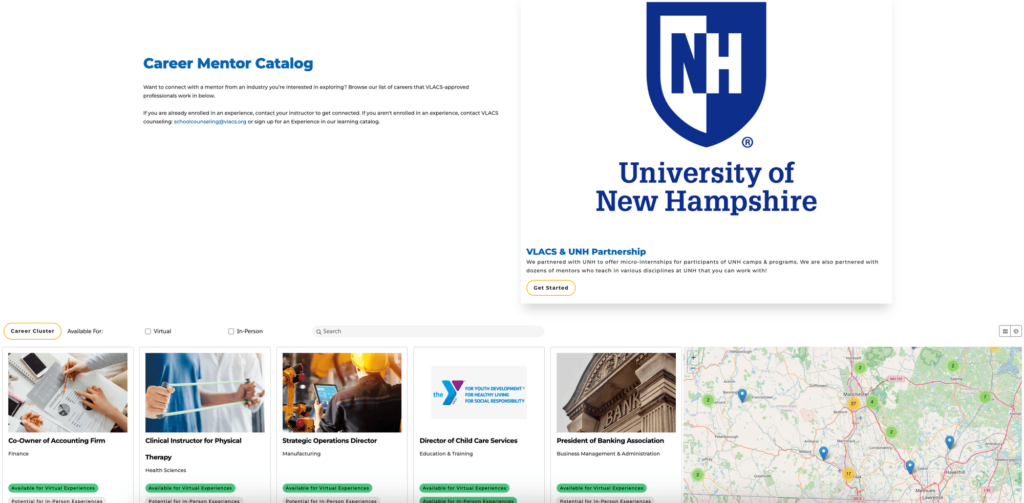In a customized learning model, students and members of their learning communities benefit from a personalized approach to learning. Students can take the best of all learning pathways, put them together in ways that make sense, and achieve mastery. The student has agency–voice–in shaping his or her experience.
What’s a learning pathway? A course. An experience. A project. College courses.
Some students may want to earn credit through just a course. Others want variety. Flexible learning pathways allow students to make that choice.
A Palette of Options
For example, a strong civics student may choose to earn one credit of history–and all of the competencies associated with it–by taking an economics course. That same strong student may also be a hands-on learner, and while a course might give her the competencies she wants, she could take some competencies as part of a course, and fulfill some of the other competencies in a project or experience.
A flexible learning pathway in a customized learning model allows her to do this.
Students can mix and match pathways to achieve competencies, pack them in their proverbial backpack, advocate for their path to achieving mastery–and credit.
A few competencies from an economics course, an economics experience, and a team project may fulfill all the competencies required for an economics credit–and the student works with an instructor to meet those competencies through the various pathways the student selects. For as many students are out there, there are nearly limitless combinations of learning opportunities.
Courses: Flexible Learning Pathways to Success
Of the four pathways, online courses are among the most common. For students who learn best through independent coursework, this pathway may make the most sense. Courses consist of groups of competencies, usually broken down into learning modules, with lessons and corresponding assessments.
How do courses work?
Content & Competencies
Online courses are comprised of competencies that students can achieve by completing lessons and assignments online.
Instructional designers, curriculum developers, and experienced teachers use a combination of standards and guidelines to determine the competencies required to earn credit, and the types of assignments that meet those competencies.
For example, a math course may consist of eight or nine competencies–or units–each with anywhere from 5-10 lessons and assessments that determine whether a student has mastered a competency.
In customized learning, students can take as much or as little time as they need to master the competencies. Students can customize their required pace charts to determine the amount of time they want to spend on the course, and the amount of work they’ll have to do each week to get there.
While the course is a pre-set package of online reading, video, audio, and interactive activities with corresponding assessments, students have access to a course instructor with whom they meet at the end of each competency, or unit.
Instructors & Discussion-Based Assessments
The course instructor is critical. In addition to a welcome call in which the instructor meets virtually with the student and their guardian, the instructor maintains regular contact with the student, offers one-on-one virtual assistance through video conferencing, and provides additional support as needed. The instructor also assesses all of the student’s work.
What happens at the end of a competency? Students and their instructors meet virtually and have a conversation that reveals whether the student has truly mastered the competencies. It’s traditionally called a Discussion-Based Assessment (DBA). Pace charts typically recommend that students spend two or three weeks per competency, but some students may need less or more time.
Each pathway has the equivalent of a DBA, where students check in with their instructors to show their mastery of a competency. In these 20-30 minute meetings, instructors also encourage students to reflect on how they mastered the competency and what helped them succeed.
In some courses and situations, students may not move on to additional competencies until they have mastered the DBA.
In other situations, students can move on to another competency, but they must schedule DBAs as they complete a competency.
The beauty of it? Students can take and re-take DBAs as often as they need to, and are encouraged to use their notes to answer questions. They can do the same with assessments and get as much or as little help as they need from their instructors.
In addition to taking DBAs as often as they need, students complete all assessments, projects, and papers as works-in-progress In the customized learning model. They can re-submit anything they need to until they achieve competency.
Students are encouraged to meet with their instructors regularly with virtual learning tools like video-conferencing, email, and online discussion boards to ask questions, gain clarification, or check in.
Flexible Schedule
In middle and high school models, courses are designed to take a school year or about nine months. Of course, in a customized learning model, a student who wants to work faster than that timetable can do so. The same holds true for a student who needs more time.
The caveat? Students need to work on their courses regularly. While they don’t need to follow specific schedules, they can and should adjust pace charts to meet their needs. A typical online course is designed to take about nine months or a traditional school year. For example, Algebra 1 is designed to take about nine months, with students spending about a month on each competency. Students in a traditional course like Algebra 1 will take their DBAs regularly, too.
Students in all courses may find some competencies easier or more difficult. As they move through their courses, they can work with their instructors to modify their pace charts to reflect the amount of time they truly need.
Students can take as much or as little time as they need.
Meet Lexy
For 16-year old Vilexyana Rios, “Lexy,” a homeschooled high school junior and aspiring singer/songwriter in Nashua, New Hampshire, a combination of courses and projects with the Virtual Learning Academy Charter School (VLACS) makes the most sense for her English, math, and world language credits.
Lexy has a passion for music, so she arranged her schedule to focus on that.
She attends her local high school for most of her music classes. Lexy plays the drums, piano, guitar, ukulele, and “lots of other percussion instruments” in her school’s jazz band, concert band, and select band. She plans to take AP music theory there next year.
On Saturdays, she plays in her local drumline. She also plays the guitar, piano, and drums for her church, in addition to working with local musicians. Lexy also enjoys writing songs.
At VLACS, Lexy attends part-time, although the school also offers full-time possibilities for middle and high school students. As a New Hampshire resident, she attends for free. Students outside of New Hampshire pay tuition to enroll in any of VLACS’s learning pathways.
For the rest of her high school credits, she combines several outside pathways.
Lexy says she’s taken “too many VLACS courses to count” in English, math, fashion and design, and Spanish.
What does she like best about the course pathway? That the courses are “at my own pace.” She usually works ahead.
Lexy adds, “I like that it’s self-directed because I can do as much or as little as I want in a day. I like the teachers. I like that it’s one-on-one. I love the fact that the teachers are there for me when I need them.”
Lexy says that the courses give her the flexibility to complete high school her terms and that she can make time in her day to focus on music, which she loves.
She explains that the courses “are fairly straightforward” and that having access to the teachers is key.
Because she’s so involved in music at school, she loves that she can work on her VLACS courses “whenever [she] needs to.” She says, “If I need to take a day off for a band thing during the day, I can take a day off of VLACS. I can do that without getting thrown off.”
Currently, Lexy is taking Algebra II with VLACS, and she’s trying a Projects pathway for her English III credit.
She explains, “I’m doing a Film Critic project for English III. We’re studying literary devices and applying them to a specific film.”
She says, “I like projects lately” because there are fewer lessons and assignments than there are in courses, but she says, “they’re harder” than the courses.
Anytime, Anywhere
The beauty of flexible learning pathways? Students decide when, where, and how they learn so that they can earn credit, pursue their passions, and become the digital leaders that the 21st century needs. Anytime. Anywhere.
Lexy’s plans for the future? She says she “might” try to graduate this year.
She plans to go to college and realize her dream of becoming a professional musician.



